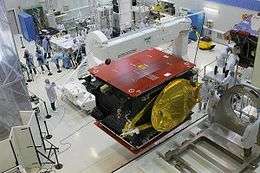ARSAT-3K
ARSAT-3K is a geostationary communications satellite bus designed and manufactured by INVAP of Argentina for the local telecommunication company ARSAT S.A..[2][3] It is a small (4.2 kW of power generation and 3,000 kg (6,600 lb) of launch mass) three axis stabilized platform designed, manufactured and tested completely in Argentina.[4][5] It is capable of carrying up to 350 kg (770 lb) of payload with a maximum power consumption of 3.4 kW at the end of life. It currently uses only chemical propulsion, but an hybrid solution which would use bi-propellant propulsion for orbit raising and electric propulsion for station keeping is being developed. A purely electric propulsion version is planned.[6]
 ARSAT-1 in INVAP. | |
| Manufacturer | INVAP |
|---|---|
| Country of origin | Argentina |
| Operator | ARSAT S.A. |
| Applications | Communications |
| Specifications | |
| Spacecraft type | Geostationary Communications satellite |
| Design life | 15 years |
| Launch mass | 2,900 kg (6,400 lb) to 3,000 kg (6,600 lb) |
| Dry mass | < 1,500 kg (3,300 lb) |
| Payload capacity | 350 kg (770 lb) and 3.5 kW[1] |
| Dimensions | Bus without payload nor solar panels:2 m (6.6 ft) × 1.8 m (5.9 ft) × 2.9 m (9.5 ft) Span with solar panels deployed: (16.5 m (54 ft) |
| Power | 4.2 kW (end of life) |
| Equipment | Ku band, Ka band and C Band payloads. |
| Regime | Geostationary |
| Production | |
| Status | In Production |
| Built | 2 |
| On order | 3 |
| Launched | 2 |
| Operational | 1 |
| Maiden launch | 16 October 2014, 21:43 UTC, ARSAT-1 |
Platform Versions
ARSAT-3K
The ARSAT-3K is the initial version of this bus. It is comparable to the Thales Alenia Space Spacebus 3000B2. It uses an integrated chemical propulsion system supplied by EADS Astrium for both orbit raising and station keeping.[7]
ARSAT-3H
The ARSAT-3H is the second version of this bus, which initiated its development during 2015. It will use an hybrid approach with bi-propellant propulsion for orbit raising and electric propulsion for station keeping.[8]
It will keep the launch mass of 3 t (6,600 lb), but have enhanced capabilities, being able to carry a 350 kg (770 lb) of payload with a maximum power consumption of 7 kW at the end of its design life.[8]
ARSAT-3E
The ARSAT-3E will be the third version of the platform. It will use electric propulsion exclusively. It will keep the payload and power envelope of the ARSAT-3H while applying the improvements to cost and weight reduction.[8]
List of satellites
The Argentine Geostationary Satellite Plan 2015-2035 (Spanish: Plan Satelital Geoestacionario Argentino 2015-2035) establishes a roadmap for the platform development until 2035.
| Satellite | Bus | Payload | Orbital Position | Launch | Status |
|---|---|---|---|---|---|
| ARSAT-1 | ARSAT-3K | Ku band | 71.8° West | 21:43:52, October 16, 2014 (UTC) | Operational |
| ARSAT-2 | ARSAT-3K | Ku band and C Band[9] | 81° West | 20:30:00, September 30, 2015 (UTC)[10] | Operational[11][12] |
| ARSAT-3 | ARSAT-3K | Ka band | 81° West | 2020[13] | In Development |
| Chemical 2 | ARSAT-3K | Ka band | TBA | TBA | Planned |
See also
References
- "Ley de desarrollo de la industria satelital" [Satellite industry development bill]. Annex I, Expediente No. 175/15 of Error: the
dateoryearparameters are either empty or in an invalid format, please use a valid year foryear, and use DMY, MDY, MY, or Y date formats fordate(in Spanish). Retrieved 2015-09-01. - "ARSAT Satellites". INVAP. Retrieved 2015-08-24.
- Belluscio, Alejandro G. (2014-10-06). "ArSat-1: Argentina to communicate its heightened space ambitions". NASA SpaceFlight. Retrieved 2015-08-25.
- "Diseño y fabricación" [Design and Manufacturing] (in Spanish). AR-SAT S.A. Archived from the original on 2016-07-27. Retrieved 2015-08-24.
- Launch Kit VA220 Intelsat 30 and ARSAT-1 (PDF). Arianespace. October 2014. Archived from the original (PDF) on 2014-12-28. Retrieved 2015-08-28.
- "Ley de desarrollo de la industria satelital" [Satellite industry development bill]. Annex I, Expediente No. 175/15 of Error: the
dateoryearparameters are either empty or in an invalid format, please use a valid year foryear, and use DMY, MDY, MY, or Y date formats fordate(in Spanish). p. 73. Retrieved 2015-09-01. - "Ley de desarrollo de la industria satelital" [Satellite industry development bill]. Annex I, Expediente No. 175/15 of Error: the
dateoryearparameters are either empty or in an invalid format, please use a valid year foryear, and use DMY, MDY, MY, or Y date formats fordate(in Spanish). p. 73, 91–95. Retrieved 2015-09-01. - "Ley de desarrollo de la industria satelital" [Satellite industry development bill]. Annex I, Expediente No. 175/15 of Error: the
dateoryearparameters are either empty or in an invalid format, please use a valid year foryear, and use DMY, MDY, MY, or Y date formats fordate(in Spanish). p. 73, 96–99. Retrieved 2015-09-01. - Belluscio, Alejandro G. (2015-09-21). "ARSAT-2: Argentina consolidates as Latin American satellite leader". NASA SpaceFlight. Retrieved 2015-10-01.
- Bergin, Chris (2015-09-30). "Ariane 5 conducts dual launch for Australia and Argentina". NASA SpaceFlight. Retrieved 2015-10-01.
- "Sin definición estratégica de Macri, ARSAT busca su destino de la mano de privados" [With no strategic definitions from President Macri, ARSAT searches for its destiny in the private sector]. Urgente 24. 2016-07-18. Retrieved 2015-08-25.
- "El ARSAT-2 llegó a órbita geoestacionaria" [The ARSAT-2 has reached the geostationary orbit] (in Spanish). ARSAT S.A. 2015-10-10. Archived from the original on 2016-07-27. Retrieved 2015-10-10.
- de Selding, Peter B. (2016-09-12). "Argentina's Arsat wants HTS Ka-band Arsat-3 sat by 2020 - 40 Gbps, 24 spot beams - with boosted domestic content". Space News. Archived from the original on 2016-09-13. Retrieved 2016-09-13.